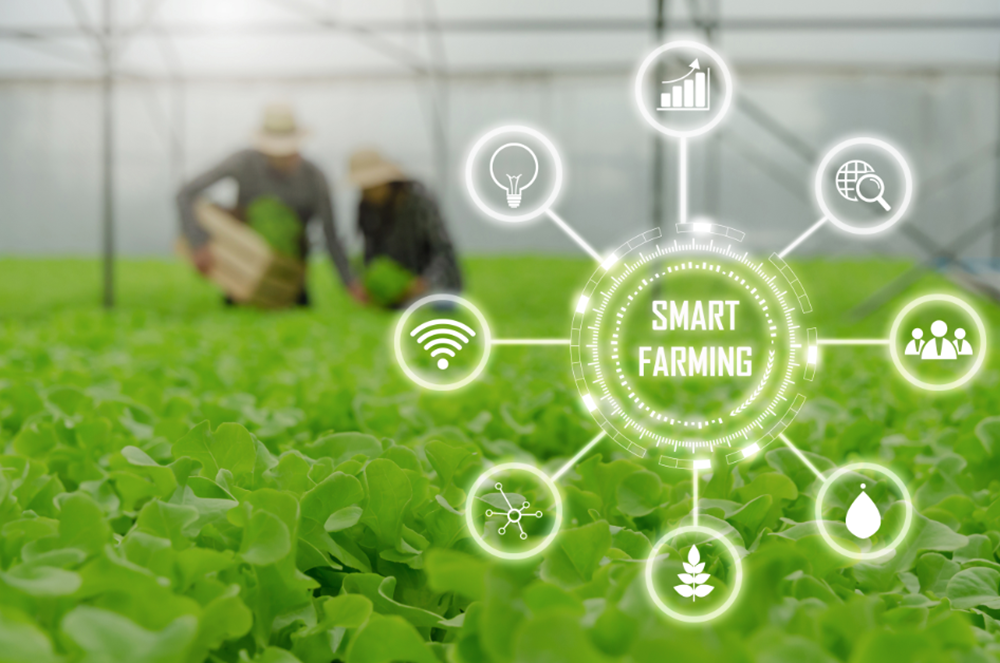Table of Contents
- How does private 5G compare to other connectivity options for agricultural applications?
- Why is private 5G a good option in rural areas?
- What are some modern agricultural innovations that private 5G connectivity can support?
Our previous blog article about private 5G discussed its benefits for applications outside of industrial automation and manufacturing. As noted, private 5G features faster data transmission, higher capacity, better reliability, and improved security compared to solutions such as WiFi. Now, let’s examine more deeply the possibilities for using private 5G to improve agriculture.
How does private 5G compare to other connectivity options for agricultural applications?
Of course, private 5G isn’t the only option for connectivity in farming. However, it has several advantages over other connectivity technologies:
- Public cellular – Public cellular networks such as 4G LTE are readily available in many locations and may be viable for some industries. However, as discussed below, public cellular infrastructure may not be available in rural farming communities. Also, the higher bandwidth and lower latency of private 5G make it more suitable for real-time applications, including livestock management and autonomous machinery.
- WiFi – WiFi can be relatively easy and inexpensive to install and may work well for connectivity in smaller areas or within buildings. However, private 5G can cover larger areas with less infrastructure. It also offers better support for mobility, enabling the use of mobile devices in the field, and better security.
- Wired solutions – While wired solutions such as fiber offer high speed and reliability, their deployment is generally impractical in sprawling agricultural settings, especially outdoors. Private 5G also offers greater flexibility and mobility than wired options.
- Satellite – In very remote areas, satellite communication may be the only option for connectivity. However, it can be quite costly for data transmission and has significantly higher latency than private 5G, making it less suitable for real-time applications.
- LoRa and similar WAN technologies – Low-power, long-range options such as LoRa can be suitable for applications that don’t require frequent and large data transmissions. However, for real-time, data-heavy agricultural applications, private 5G will better meet the performance requirements for high bandwidth and low latency.
Why is private 5G a good option in rural areas?
Connectivity enables the use of technologies to improve agricultural operations in many ways. It can improve access to expert consultations and other information that can guide agricultural practices.
However, many rural farming communities lack the necessary infrastructure for technologies like fiber and public cellular. Establishing such infrastructure requires significant investment, often more than even large farms can manage. It can also be challenging to implement such infrastructure without disrupting operations. Also, rural farmlands can often be sprawling, presenting additional challenges when using other connectivity technologies to cover the entire farming operation.
While it isn’t inexpensive and does require some infrastructure, private 5G offers a strong alternative in providing connectivity to rural areas that would otherwise be inaccessible. Private 5G solutions can cover the entire property, no matter how sprawling, with fast, reliable, secure connectivity to support technological innovation for improved farming.
What are some modern agricultural innovations that private 5G connectivity can support?
As farmers continue to recognize its benefits, the global market for smart farming technology has continued to increase. Some analysts project growth rates upwards of 18% between now and 2030. Technology can help farmers use data to reduce waste and costs, improve efficiency, manage resources, and reduce their environmental footprint. However, this approach requires connectivity to support data transmission, IoT controls, and more. Here are some ways to leverage the benefits of private 5G:
- Precision agriculture – These solutions use networked sensors to collect real-time data on lighting, temperature, soil condition, humidity, CO2 levels, and pest infections. Devices can gather data specifically for a plot or a crop. After immediate (often AI-assisted) data analysis, other networked devices can make adjustments quickly and automatically for improved outcomes.
- Climate and weather monitoring – A subset of precision agriculture, these solutions collect data on climate and weather to determine irrigation needs, adjust watering schedules, and more. Farmers can also use this information to determine what crops to plant where, or where to graze livestock.
- Soil and crop health monitoring – Similarly, these solutions can continuously monitor soil health, crop growth, and more and recommend necessary adjustments.
- Smart irrigation – Along with climate, soil, and crop data, these solutions can automatically water as needed to maintain optimal crop health.
- Livestock monitoring and management – These solutions can keep track of not just the location but also the well-being of livestock. They can provide insights on things like activity, nutrition, and temperature and even identify sick animals for separation and treatment.
- Smart greenhouses – In a similar vein, smart greenhouse solutions can monitor things like temperature, lighting, humidity, and soil conditions. They can also make adjustments to conditions as needed for optimal crop growth.
- Drones and autonomous machinery – Not only can drones collect data across large areas, but they can also plant seeds, treat for pests and infections, and apply spray treatments. Autonomous machinery such as tractors can perform rote work on pre-determined routes. Smart farming robots can even detect weeds and plant seeds using computer vision and AI-assisted analysis.
- Supply chain tracking – From the fields to various processing facilities and distribution centers, real-time tracking can provide data for improved logistics and timely delivery.
- Predictive analytics and end-to-end management – Sensor data combined with analytics tools can help make outcomes more efficient and predictable. This reduces costs, cuts waste, and guides the optimal use of resources. The most powerful end-to-end management solutions can tie together information about a farm’s entire operations with data and insights to make continued improvements year after year.
- Augmented reality (AR) – Farmers with AR devices can implement data overlays to gain insight into crop conditions, equipment status, and more.
Are you interested in finding out how private 5G can benefit your operations? An expert integrator like Sparro can help you navigate the potential pitfalls and avoid costly mistakes. We can also coordinate with Tier 1 carriers and establish SLAs for better results that help you achieve your goals.

